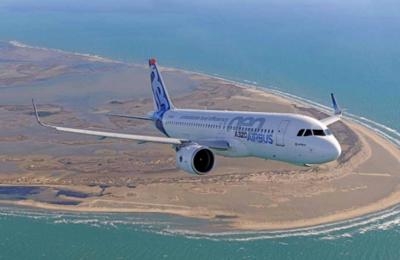Company Says It 'Overachieved' On All Key Performance Indicators
Airbus SE has reported its 2017 financial results and provided an outlook for 2018. The company says it exceeded its 2017 guidance for all key performance indicators, driven by a strong underlying performance.

“We overachieved on all our 2017 KPIs thanks to a very good operational performance, especially in the last quarter,” said Airbus Chief Executive Officer Tom Enders. “Despite persistent engine issues on the A320neo, we continued the production ramp-up and finally delivered a record number of aircraft. On A400M, we made progress on the industrial and capabilities front and agreed a re-baselining with government customers which will significantly reduce the remaining program risks. This is reflected in a substantial one-off charge. Overall, the strength of our 2017 achievements is reflected in our dividend proposal which is up 11 percent against last year. This also endorses our earnings and cash growth story for the future.”
Order intake increased to € 158 billion (approx. $197 billion) with the order book valued at € 997 billion (approx. $1.24 trillion) as of 31 December 2017 (year-end 2016: € 1,060 billion or approx. $1.32 trillion). A total of 1,109 net commercial aircraft orders were received (2016: 731 aircraft), with a book-to-bill ratio of 1.5. The backlog by units reached a record year-end level of 7,265 commercial aircraft. Net helicopter orders totalled 335 units (2016: 353 units), including 48 Super Puma Family rotorcraft and 17 H175s. By value in euros, the book-to-bill ratio in Helicopters was around 1. At Defense and Space, good momentum was seen in military aircraft with the order intake including 22 light and medium transport aircraft, five A330 MRTT tankers and the Eurofighter contract with Kuwait. Two all-electric telecommunication satellites were booked in the fourth quarter despite a soft market environment. Defense and Space’s perimeter changes had a negative impact of € 1.9
billion (approx. $2.37 billion) on the order book and € 1.5 billion (approx. $1.87 billion) on order intake.
Revenues were stable at € 66.8 billion (approx. $88 billion) with higher aircraft deliveries offset by a reduction in revenues of around € 2 billion (approx. $2.5 billion) from the perimeter changes. Commercial Aircraft revenues rose by 3.5 percent with record deliveries of 718 aircraft (2016: 688 aircraft) comprising 558 A320 Family, 78 A350 XWBs, 67 A330s and 15 A380s. Helicopters’ revenues were slightly lower with deliveries of 409 units (2016: 418 units). Revenues at Defense and Space reflected the Division’s perimeter changes of around € 1.7 billion but were seven percent higher on a comparable basis driven mainly by military aircraft.
A total of 181 A320neo Family aircraft were delivered, up from 68 during 2016. Supplier Pratt & Whitney introduced new engine fixes in the fourth quarter which have been certified. A new issue has arisen recently, the impact of which is under assessment with respect to 2018 deliveries. CFM International meanwhile experienced some maturity issues in 2017 on some batches of the LEAP-1A engine. The A320neo ramp-up remains challenging and requires that the engine suppliers deliver in line with commitments. On the A350, good progress was made with the industrial ramp-up, recurring cost convergence and the reduction of outstanding work in the Final Assembly Line, which has been significantly reduced. The A350 program is preparing to reach the targeted monthly production rate of 10 by the end of 2018. Meanwhile, Emirates Airline’s latest order provides increased visibility on the A380 program for the years to come.

Helicopters’ Earnings Before Interest & Tax (EBIT) Adjusted declined to € 337 million (approx. $420 million) but was broadly stable on a comparable basis. Lower deliveries, an unfavorable mix and lower commercial flight hours in services were compensated by transformation efforts which have globally supported the Division’s competitiveness in a challenging market. The sale of the maintenance, repair and overhaul business Vector Aerospace was closed in November.
Defense and Space’s EBIT Adjusted amounted to € 872 million (approx. $1.08 billion), reflecting the perimeter changes but was broadly stable on a comparable basis.
On the A400M program, good progress was made on the industrial side with 19 aircraft delivered compared to 17 in 2016. The production rate was adjusted to recalibrate inventory levels while the military capability roadmap was re-baselined. In 2017, Airbus entered into discussions with OCCAR and the customer Nations that resulted in the signature of a Declaration of Intent (DoI) in February agreeing on a global re-baselining of the contract, including a revised aircraft delivery schedule, an updated technical capability roadmap and a revised retrofit schedule. The DoI represents an important step towards reaching a contractually binding agreement also mitigating the commercial exposure while satisfying customer needs with regard to capabilities and availability of the aircraft. With a clear roadmap in place, Airbus’ remaining exposure going forward is expected to be more limited. A detailed review of the program concluded in the fourth quarter of 2017 including an estimate of the financial impact
of the adaptions on schedule, capabilities and retrofit resulted in an update of the Loss Making Contract provision of € 1,299 million for the year.
Net income increased to € 2,873 million (approx. $3.6 billion) after the EBIT Adjustments.
As the basis for its 2018 guidance, Airbus expects the world economy and air traffic to grow in line with prevailing independent forecasts, which assume no major disruptions.
(Source: Airbus news release)
 Classic Aero-TV: The Switchblade Flying Car FLIES!
Classic Aero-TV: The Switchblade Flying Car FLIES! ANN FAQ: Q&A 101
ANN FAQ: Q&A 101 ANN's Daily Aero-Term (04.12.24): Discrete Code
ANN's Daily Aero-Term (04.12.24): Discrete Code ANN's Daily Aero-Term (04.13.24): Beyond Visual Line Of Sight (BVLOS)
ANN's Daily Aero-Term (04.13.24): Beyond Visual Line Of Sight (BVLOS) ANN's Daily Aero-Linx (04.13.24)
ANN's Daily Aero-Linx (04.13.24)



